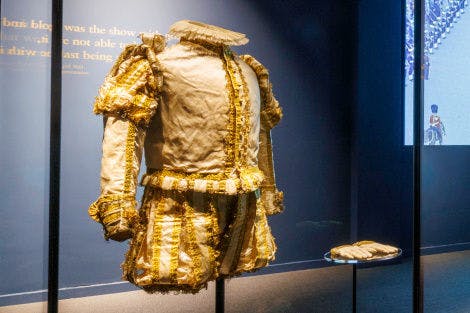Beating the Bounds
A centuries-old tradition
Date: 19 May 2017
In medieval and early modern society, a parish was a community: it was where you were christened, married and buried; the parish church set the tithes to pay and provided spiritual nourishment and security in return. Knowing the boundaries of the parish was crucial to a community's identity and the residents' responsibilities.
On the evening of Ascension Day, a group from every parish and various governing bodies in England would walk around the parameters of their land. Each boundary post would be beaten to mark it out in the minds of the younger generations and the clergy would pray for the land along the way. This tradition was known as Beating the Bounds.
Modern maps have made the geographical purpose of the ceremony obsolete, yet a number of communities across the UK continue to beat their bounds in honour of the ancient tradition, including the Tower of London.
Tower tradition
The area surrounding the Tower is known as the 'Tower Liberties'. This area is under the jurisdiction of the Tower of London and independent of the City of London; up until 1894, the Tower Liberties had their own county government. This independent status made it vital for residents to be aware of the Tower's boundaries.
There are 22 surviving boundary markers surrounding the Tower, many bearing the letters WD for War Department from the 19th century, and each one is visited when Beating the Bounds. Since the fourteenth century, the location of the markers was firmly impressed on the minds of young members of the community through the procession. Armed with willow wands, choir boys and local children beat the markers at the command of the Warders and the Chaplain.
The tradition, as well as marking territory and protecting the land from evil spirits, was seen as an important community event. If not participating in the walk, residents of the area would have joined in the preceding church service or provided drinks and light refreshments along the way for the walkers.
A neighbourly feud
The neighbouring parish of All Hallows perform the ceremony of Beating the Bounds every year. When All Hallows and the Tower of London meet along the way a "battle" might ensue. In the middle ages, the boundary mark shared by the Tower and All Hallows parish was always in dispute.
This (now friendly) confrontation marks an occasion in 1698 when a riot erupted between the people of the Tower and the All Hallows walkers.
Seven centuries and counting
Today, the ancient tradition is kept alive by the Tower residents, officials and local schools. Following the customs set some seven centuries ago, the ceremony takes place every three years on the evening Ascension Day.
The procession is led by the Chaplain of St Peter ad Vincula and the Chief Yeoman Warder, followed by school children, the choir and Master of Music, the Yeoman Warders and other Tower officials and their families. The ceremony opens with Evensong in St Peter ad Vincula inside the Tower precincts and concludes with the National Anthem sung on Tower Green, followed by the (equally traditional) refreshments in the Chapel Crypt.
More from our blog

The New Constable of the Tower of London
04 October 2022
General Sir Gordon Messenger became the 161st Constable of the Tower of London in August 2022, succeeding General The Lord Nicholas Houghton. The role of the Constable is the most senior appointment at the Tower of London and dates back to the time of William the Conqueror and the Norman Conquest.

Excavations at the Tower of London's chapel
21 October 2019
Historic Buildings Curator Alfred Hawkins explains the process of archaeological excavations, and their importance in expanding our current understanding of historic sites like the Tower of London.

Royal Ceremonial Dress Collection in the Jewel House
26 June 2023
Curator Charles Farris introduces some of the amazing ceremonial dress now on display in the Jewel House exhibition.




